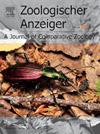描述了欧洲大陆第一个猎人蛛(蜘蛛目,蛛蛛科)种,证实了该属在该地区的存在
IF 1.5
3区 生物学
Q2 ZOOLOGY
引用次数: 0
摘要
由于气候和栖息地的多样性,伊比利亚半岛拥有丰富多样的蜘蛛动物群,包括许多地方性动物。对于干旱和半干旱地区这样的栖息地来说尤其如此。尽管其中有一些有趣的——有时是没有特征的——动物,比如猎蛛属的猎人蜘蛛,但它们中的许多都受到了威胁。以前人们知道这些蜘蛛出现在北非到中东,但在欧洲的新发现引起了人们的注意。在这里,我们使用形态学和分子数据来描述一个来自西班牙东部标本的新物种。此外,我们使用遗传数据将新物种cerbrennus herculis sp. n.置于系统发育背景下,并推测导致其出现在欧洲的生物地理过程。3个分子标记(COI、18S和28S)的遗传距离较低。我们的系统发育树恢复了伊比利亚羊brennus的单系,并将它们作为唯一具有遗传数据的非洲代表羊brennus rungsi的姐妹。此外,分化时间分析揭示了伊比利亚谱系和C. rungsi之间的古近纪-新近纪分裂,这与欧洲和非洲大陆之间古代联系之后的异域物种形成相一致。这些发现表明,干旱和半干旱地区等栖息地仍然隐藏着新的和有趣的多样性,强调了保护它们的重要性。本文章由计算机程序翻译,如有差异,请以英文原文为准。
Description of the first continental European species of the huntsman spider Cebrennus (Araneae, Sparassidae), confirming the presence of the genus in the region
Because of its wide variety of climates and habitats, the Iberian Peninsula harbors a rich and diverse arachnological fauna, including numerous endemisms. This is especially true for habitats like arid and semiarid areas. Many of them are threatened despite containing interesting –and sometimes uncharacterised– fauna, such as the huntsman spiders in the genus Cebrennus.
Previously known to occur from North Africa to the Middle East, new sightings of these spiders in Europe have drawn attention. Here, we use morphological and molecular data to describe a new species of Cebrennus from specimens collected in eastern Spain. Additionally, we use genetic data to place the new species, Cebrennus herculis sp. n., in a phylogenetic context and speculate on the biogeographic processes that lead to its presence in Europe.
Genetic distances among individuals of C. herculis sp. n. were low for the three molecular markers analysed (COI, 18S and 28S). Our phylogenetic tree recovered the monophyly of the Iberian Cebrennus, and placed them as sister to the only African representative with genetic data available, Cebrennus rungsi. Furthermore, divergence time analysis revealed a Palaeogene-Neogene split between the Iberian lineage and C. rungsi, compatible with an allopatric speciation following one of the ancient connections between Europe and Africa landmasses.
These findings show that habitats such as arid and semiarid areas still hide new and interesting diversity, underscoring the importance of preserving them.
求助全文
通过发布文献求助,成功后即可免费获取论文全文。
去求助
来源期刊

Zoologischer Anzeiger
生物-动物学
CiteScore
2.80
自引率
7.10%
发文量
75
审稿时长
>12 weeks
期刊介绍:
Zoologischer Anzeiger - A Journal of Comparative Zoology is devoted to comparative zoology with a special emphasis on morphology, systematics, biogeography, and evolutionary biology targeting all metazoans, both modern and extinct. We also consider taxonomic submissions addressing a broader systematic and/or evolutionary context. The overall aim of the journal is to contribute to our understanding of the organismic world from an evolutionary perspective.
The journal Zoologischer Anzeiger invites suggestions for special issues. Interested parties may contact one of the editors.
 求助内容:
求助内容: 应助结果提醒方式:
应助结果提醒方式:


